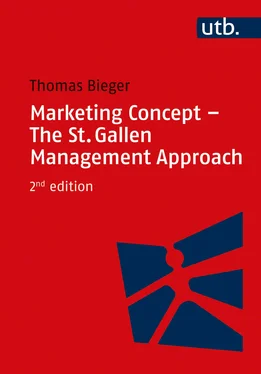Fig. 14: Calculation of value creation
Fig. 15: Structure of business processes
Fig. 16: Service-provision process as a value-creation chain
Fig. 17: Business process: goods and services
Fig. 18: Service chain in incoming tourism
Fig. 19: The customer buying cycle
Fig. 20: Structure of a brand according to Aaker (1992) using the HSG as an example
Fig. 21: Five-phase product life-cycle model
Fig. 22: Development of marketing
Fig. 23: Marketing concept
Fig. 24: Customer system
Fig. 25: Benefits of long-term customer commitment
[14]
Fig. 26: Transaction relationships in e-commerce
Fig. 27: Composition of demand
Fig. 28: Purchase decision for holiday travels
Fig. 29: SOR behavioral model
Fig. 30: Theory of planned behavior
Fig. 31: Market sizes
Fig. 32: Importance of specific information sources in tourism
Fig. 33: Travel motivation (1+ overnights)
Fig. 34: Types of trends
Fig. 35: Development of trends
Fig. 36: Systematic analysis of new trends using the example of scooters
Fig. 37: Example of a simplified tourism system and its dynamics
Fig. 38: Market analysis as part of the marketing concept
Fig. 39: Matrix of a SWOT analysis
Fig. 40: Strength and weakness analysis of a typical Swiss destination
Fig. 41: Demand trends and opportunities and threats deduced from them for a Swiss destination
Fig. 42: Marketing strategy within the marketing concept
Fig. 43: Goal hierarchy in marketing (exemplary)
Fig. 44: From market segmentation to differentiation
Fig. 45: Optimal segmentation
Fig. 46: Multi-stage market segmentation for the skiing market
Fig. 47: Statistical market segmentation by motives with the help of cluster analyses
Fig. 48: Ways of illustrating brand positioning
Fig. 49: Industry environment conditions and basic strategies for customer acquisition
Fig. 50: Why customer retention pays off
Fig. 51: The main tasks of customer retention
Fig. 52: Overview of marketing tools
Fig. 53: Detailed planning of a marketing mix — marketing plan
Fig. 54: From customer value to value of the customer
Fig. 55: Conception levels for the product
Fig. 56: Goods and services typology
Fig. 57: Alternative decisions depending on program policy
Fig. 58: Basic structure of the physical performance process
Fig. 59: Basic structure of performance process
Fig. 60: Possible roles of companies in a value chain
Fig. 61: Types of business operations
[15]
Fig. 62: Characteristic features of services
Fig. 63: Demarcation between service and material good
Fig. 64: Service chain in incoming tourism — destination point of view
Fig. 65: Individual service chain
Fig. 66: Service chain in outgoing tourism — perspective travel as a whole and travel agency
Fig. 67: Concept of a service chain from a customer’s perspective
Fig. 68: Demand curve as an aggregation of individual preferences
Fig. 69: Price effect elasticities
Fig. 70: Assimilation contrast theory
Fig. 71: Price determination
Fig. 72: Yield management systems
Fig. 73: Yield management for booking systems
Fig. 74: Strategic distribution
Fig. 75: Example: Sales channel in tourism
Fig. 76: Distribution system
Fig. 77: Development prospects in distribution
Fig. 78: General communication process and marketing communication process
Fig. 79: Communication organization
Fig. 80: Communication tools
Fig. 81: Examples for tool goals in marketing
Fig. 82: Detailed planning marketing mix — marketing plan
Fig. 83: Marketing mix within the buying cycle
Fig. 84: Dimensions of business models
Fig. 85: Interaction of business model components of airlines
Fig. 86: Management function according to Fayol
Fig. 87: Possible indicators for measuring marketing’s success during a relaunch
Fig. 88: Goal hierarchy and controlling
Fig. 89: Product-specific multi-level contribution-accounting analysis
Fig. 90: Swiss International Air Lines controlling structure
Fig. 91: Return on investment between the poles of innovation push and pull
Fig. 92: The innovation process
Fig. 93: Required innovation according to industry and goods
Fig. 94: Innovation cube for the classification of strategic directions of impact
Fig. 95: Marketing concept
Конец ознакомительного фрагмента.
Текст предоставлен ООО «ЛитРес».
Прочитайте эту книгу целиком, купив полную легальную версию на ЛитРес.
Безопасно оплатить книгу можно банковской картой Visa, MasterCard, Maestro, со счета мобильного телефона, с платежного терминала, в салоне МТС или Связной, через PayPal, WebMoney, Яндекс.Деньги, QIWI Кошелек, бонусными картами или другим удобным Вам способом.












